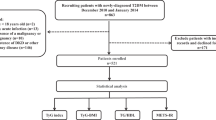Abstract
Background
The urine dipstick test that regards > 1+ proteinuria as positive is unsuitable for microalbuminuria screening owing to its low sensitivity in the general population. We conducted a cross-sectional survey to examine whether trace proteinuria could be an indicator of microalbuminuria.
Methods
The subjects were 2321 participants in a community-based health check-up in Takahata, Japan. Dipstick tests for proteinuria and the urine albumin–creatinine ratio (UACR) measurement were performed with single-spot urine specimens collected early in the morning. The results of the dipstick tests were recorded as (−), trace, (1+), (2+), and (3+). Micro- and macroalbuminuria were defined as UACR 30–300 mg/g and > 300 mg/g, respectively.
Results
Overall, the prevalence and median UACR levels of urine protein (−), trace, (1+), (2+), and (3+) were 92.0% (8.8 mg/g), 3.5% (43 mg/g), 2.6% (81 mg/g), 1.4% (315 mg/g), and 0.5% (1073 mg/g), respectively. Within the trace proteinuria category, the prevalence of microalbuminuria in all subjects, men, subjects ≥60 years, diabetic subjects, and hypertensive subjects was 59.3%, 73.8%, 71.2%, 88.9%, and 68.0%, respectively. By regarding trace proteinuria as positive, the sensitivity of the urine protein dipstick test for micro- and macroalbuminuria was improved (from 23.3% to 37.1%), while its specificity was not significantly changed (from 98.9% to 97.3%).
Conclusion
Trace proteinuria could be a useful indicator of microalbuminuria in the general population, and especially in subjects at high risk of cardiovascular disease.
Similar content being viewed by others
References
HL Hillege WM Janssen AA Bak GF Diercks DE Grobbee HJ Crijns et al. (2001) ArticleTitleMicroalbuminuria is common also in a nondiabetic, nonhypertensive population, and an independent indicator of cardiovascular risk factors and cardiovascular morbidity J Intern Med 249 519–26 Occurrence Handle11422658 Occurrence Handle10.1046/j.1365-2796.2001.00833.x Occurrence Handle1:STN:280:DC%2BD3Mznt1artg%3D%3D
S Soonthornpun N Thammakumpee A Thamprasit C Rattarasarn R Leelawattana W Setasuban (2000) ArticleTitleThe utility of conventional dipsticks for urinary protein for screening of microalbuminuria in diabetic patients J Med Assoc Thai 83 797–803 Occurrence Handle10932516 Occurrence Handle1:STN:280:DC%2BD3cvivFWquw%3D%3D
R Sam MS Shaykh AA Pegoraro V Khalili I Hristea AK Singh et al. (2003) ArticleTitleThe significance of trace proteinuria Am J Nephrol 23 438–41 Occurrence Handle14583662 Occurrence Handle10.1159/000074535 Occurrence Handle1:CAS:528:DC%2BD3sXptVWkt7o%3D
A Zeller JP Sigle E Battegay B Martina (2005) ArticleTitleValue of a standard urinary dipstick test for detecting microalbuminuria in patients with newly diagnosed hypertension Swiss Med Weekly 135 57–61
T Konta Z Hao H Abiko M Ishikawa T Takahashi A Ikeda et al. (2006) ArticleTitlePrevalence and risk factor analysis of microalbuminuria in Japanese general population: the Takahata study Kidney Int 70 751–6 Occurrence Handle16807548 Occurrence Handle10.1038/sj.ki.5001504 Occurrence Handle1:CAS:528:DC%2BD28XnvVylt7o%3D
InstitutionalAuthorNameWHO/IASO/IOTF (2000) The Asia–Pacific perspective: redefining obesity and its treatment Health Communications Sydney, Australia 15–21
WF Keane G Eknoyan (1999) ArticleTitleProteinuria, albuminuria, risk, assessment, detection, elimination (PARADE): a position paper of the National Kidney Foundation Am J Kidney Dis 33 1004–10 Occurrence Handle10213663 Occurrence Handle1:STN:280:DyaK1M3jtVWktQ%3D%3D
AS Levey JP Bosch JB Lewis T Greene N Rogers D Roth (1999) ArticleTitleA more accurate method to estimate glomerular filtration rate from serum creatinine: a new prediction equation. Modification of Diet in Renal Disease Study Group Ann Intern Med 130 461–70 Occurrence Handle10075613 Occurrence Handle1:CAS:528:DyaK1MXitFChs7k%3D
H Tanaka Y Shiohira Y Uezu A Higa K Iseki (2006) ArticleTitleMetabolic syndrome and chronic kidney disease in Okinawa Japan Kidney Int 69 369–74 Occurrence Handle16408128 Occurrence Handle10.1038/sj.ki.5000050 Occurrence Handle1:STN:280:DC%2BD28%2FitVOgsw%3D%3D
K Iseki Y Ikemiya C Iseki S Takishita (2003) ArticleTitleProteinuria and the risk of developing end-stage renal disease Kidney Int 63 468–74 Occurrence Handle10.1046/j.1523-1755.2003.00868.x
A Pegoraro A Singh AA Bakir JA Arruda G Dunea (1997) ArticleTitleSimplified screening for microalbuminuria Ann Intern Med 127 817–9 Occurrence Handle9382403 Occurrence Handle1:STN:280:DyaK1c%2FgtVOmug%3D%3D
LE Boulware BG Jaar ME Tarver-Carr FL Brancati NR Powe (2003) ArticleTitleScreening for proteinuria in US adults: a cost-effectiveness analysis JAMA 290 3101–14 Occurrence Handle14679273 Occurrence Handle10.1001/jama.290.23.3101 Occurrence Handle1:CAS:528:DC%2BD3sXpvFKjtLw%3D
NL Meyer BM Mercer SA Friedman BM Sibai (1994) ArticleTitleUrinary dipstick protein: a poor predictor of absent or severe proteinuria Am J Obstet Gynecol 170 137–41 Occurrence Handle8296815 Occurrence Handle1:STN:280:DyaK2c7islCqsQ%3D%3D
InstitutionalAuthorNameAmerican Diabetes Association (1997) ArticleTitleClinical practice recommendations 1997 Diabetes Care 20 IssueIDSuppl 1 S1–70
PH Bennett S Haffner BL Kasiske WF Keane CE Mogensen HH Parving et al. (1995) ArticleTitleScreening and management of microalbuminuria in patients with diabetes mellitus: recommendations to the Scientific Advisory Board of the National Kidney Foundation from an ad hoc committee of the Council on Diabetes Mellitus of the National Kidney Foundation Am J Kidney Dis 25 107–12 Occurrence Handle7810516 Occurrence Handle1:STN:280:DyaK2M7gvFGhsg%3D%3D
R Correa-Rotter S Naicker IJ Katz SK Agarwal R Herrera Valdes D Kaseje et al. (2004) ArticleTitleISN–COMGAN Bellagio Study Group 2004. Demographic and epidemiologic transition in the developing world: role of albuminuria in the early diagnosis and prevention of renal and cardiovascular disease Kidney Int Suppl 92 S32–7 Occurrence Handle10.1111/j.1523-1755.2004.09208.x
RC Atkins EM Briganti PZ Zimmet SJ Chadban (2003) ArticleTitleAssociation between albuminuria and proteinuria in the general population: the AusDiab Study Nephrol Dial Transplant 18 2170–4 Occurrence Handle13679498 Occurrence Handle10.1093/ndt/gfg314
J Johnston KR Paterson DS O'Reilly (1993) ArticleTitleEstimating urinary albumin excretion rate of diabetic patients in clinical practice BMJ 306 493–4 Occurrence Handle8448461 Occurrence Handle1:STN:280:DyaK3s7pt1KqtA%3D%3D Occurrence Handle10.1136/bmj.306.6876.493-a
PE de Jong GC Curhan (2006) ArticleTitleScreening, monitoring, and treatment of albuminuria: public health perspectives J Am Soc Nephrol 17 2120–6 Occurrence Handle16825331 Occurrence Handle10.1681/ASN.2006010097
H Ibsen K Wachtell MH Olsen K Borch-Johnsen LH Lindholm CE Mogensen et al. (2004) ArticleTitleAlbuminuria and cardiovascular risk in hypertensive patients with left ventricular hypertrophy: the LIFE study Kidney Int Suppl 92 S56–8 Occurrence Handle10.1111/j.1523-1755.2004.09214.x
Author information
Authors and Affiliations
Corresponding author
About this article
Cite this article
Konta, T., Hao, Z., Takasaki, S. et al. Clinical utility of trace proteinuria for microalbuminuria screening in the general population. Clin Exp Nephrol 11, 51–55 (2007). https://doi.org/10.1007/s10157-006-0458-z
Received:
Accepted:
Published:
Issue Date:
DOI: https://doi.org/10.1007/s10157-006-0458-z




